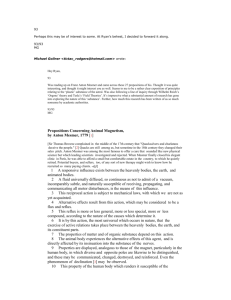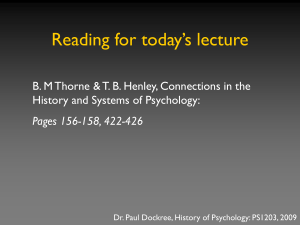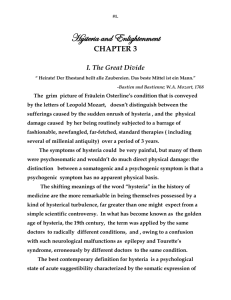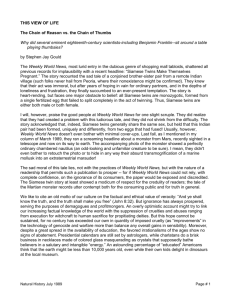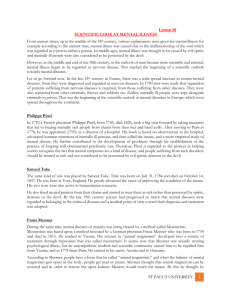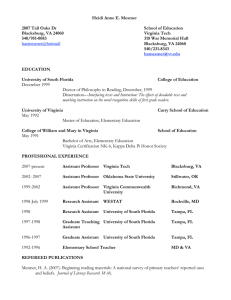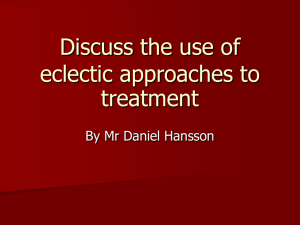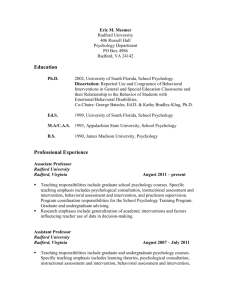Chapter Four: Mesmer's Influence On Modem Therapies
advertisement
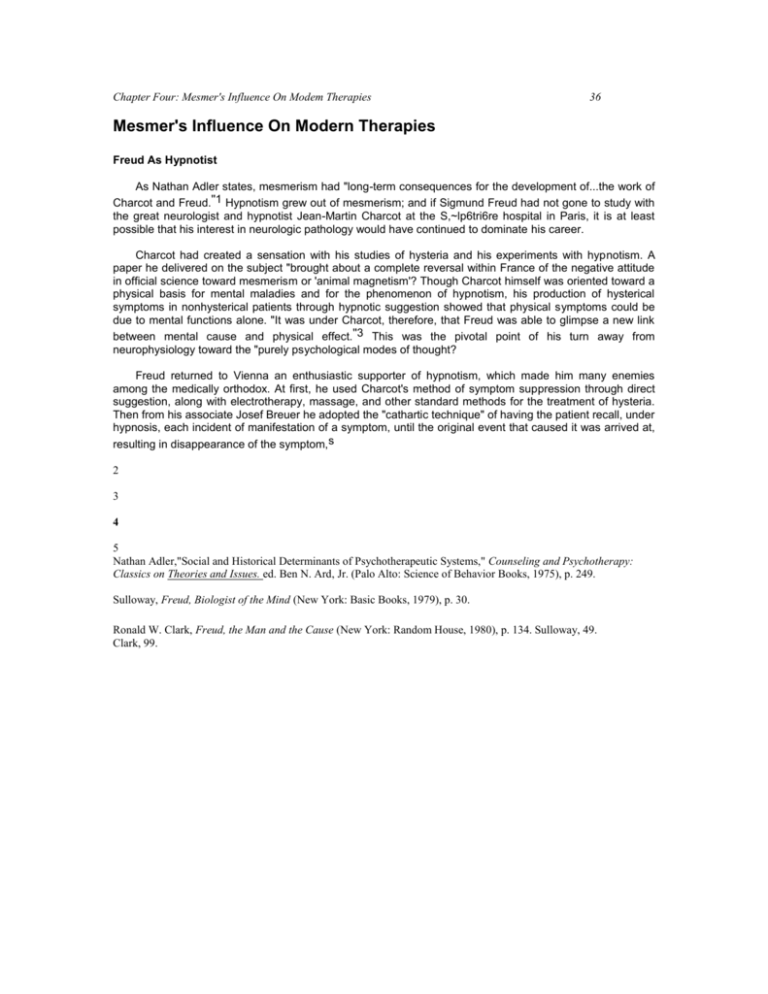
Chapter Four: Mesmer's Influence On Modem Therapies 36 Mesmer's Influence On Modern Therapies Freud As Hypnotist As Nathan Adler states, mesmerism had "long-term consequences for the development of...the work of Charcot and Freud.''1 Hypnotism grew out of mesmerism; and if Sigmund Freud had not gone to study with the great neurologist and hypnotist Jean-Martin Charcot at the S,~lp6tri6re hospital in Paris, it is at least possible that his interest in neurologic pathology would have continued to dominate his career. Charcot had created a sensation with his studies of hysteria and his experiments with hypnotism. A paper he delivered on the subject "brought about a complete reversal within France of the negative attitude in official science toward mesmerism or 'animal magnetism'? Though Charcot himself was oriented toward a physical basis for mental maladies and for the phenomenon of hypnotism, his production of hysterical symptoms in nonhysterical patients through hypnotic suggestion showed that physical symptoms could be due to mental functions alone. "It was under Charcot, therefore, that Freud was able to glimpse a new link between mental cause and physical effect.''3 This was the pivotal point of his turn away from neurophysiology toward the "purely psychological modes of thought? Freud returned to Vienna an enthusiastic supporter of hypnotism, which made him many enemies among the medically orthodox. At first, he used Charcot's method of symptom suppression through direct suggestion, along with electrotherapy, massage, and other standard methods for the treatment of hysteria. Then from his associate Josef Breuer he adopted the "cathartic technique" of having the patient recall, under hypnosis, each incident of manifestation of a symptom, until the original event that caused it was arrived at, resulting in disappearance of the symptom,s 2 3 4 5 Nathan Adler,"Social and Historical Determinants of Psychotherapeutic Systems," Counseling and Psychotherapy: Classics on Theories and Issues. ed. Ben N. Ard, Jr. (Palo Alto: Science of Behavior Books, 1975), p. 249. Sulloway, Freud, Biologist of the Mind (New York: Basic Books, 1979), p. 30. Ronald W. Clark, Freud, the Man and the Cause (New York: Random House, 1980), p. 134. Sulloway, 49. Clark, 99. Chapter Four: Mesmer's Influence On Modem Therapies 37 Before long, though, Freud experienced difficulties with hypnotism: he was unable to hypnotize some patients; others could not be brought to the state of deep hypnosis necessary for catharsis. In an attempt to improve his technique, Freud went to Nancy to observe the methods of the highly acclaimed hypnotists, Bernheim and Liebeault. Bernheim, unlike Charcot, held an "ideogenic" theory of hypnosis which attributed the hypnotic process and its effects purely to suggestion.6 From him Freud learned a technique of commanding a patient with hypnotically produced amnesia to remember, while the therapist applied hand pressure to the forehead (reminiscent of Mesmerism), to "help the patient tap the forgotten state of consciousness. Freud therefore surmised that his own unhypnotizable patients also knew the seemingly forgotten traumas...and he resolved to extract this information without hypnosis." He finally found the mesmeric "laying on of hands" unnecessary, and simply let the patient talk about whatever occurred to him or her.7 Thus began the technique of free association, and the beginnings of psychoanalysis. Freud had removed himself from the sphere of mesmeric technique (ritual, physical contact, intervention, etc.) There was also an overt event that led to his final abandonment of hypnotism. "While one of his patients was undergoing the cathartic treatment, on waking she suddenly embraced Freud." He says that he had now grasped 'the mysterious element that was at work behind hypnotism." It suffices to note that Freud had unwittingly encouraged the "magnetic passion" of the old mesmerists.8 The "mysterious element" was, of course, sexual attraction. Though he often criticized hypnotism after discarding it, in part on the grounds that it was a cumbersome method, and that symptoms removed by suggestion often returned or were replaced by others, some appreciation of its potential must have remained, for in 1918, commenting on the use of hypnotism in treating shell-shock, he said, "1 myself would reach back for the hypnotic method if faced with similar case material and for certain psychoses? Freud was not an especially good hypnotist, lacking the charisma and authority of a Char-cot, who could often produce a deep trance state in a patient by a single command. Had he been highly proficient, he probably would have continued some regular use of the technique, and though he undoubtedly still would have developed his psychoanalytic theories, their application SuUoway, 46. /bM., 73-74.8 A. R. G. Owen, Hysteria, Hypnosis and Healing:. The Work of J. M. Charcot (New York: Gar-rett Publications, 1971), p. 205. Clark, 387. Chapter Four: Mesmer's Influence On Modem Therapies 38 would necessarily have been far different. Homeopathy Samuel Hahnemann (1755-1843),1° the founder of homeopathy, credited many who came before him--from Hippocrates to Mesmer--with the concept of similars ("like cures like"), but it was he who systematized it into a methododology of medical treatment based on the theory that diseases can be treated by giving small doses of chemical compounds that in a healthy person would produce symptoms like those of the disease. There are many correspondences between Mesmer's and Hahnemann's views and techniques. Both believed in the necessity of inducing a "crisis," as Mesmer termed it; Hahnemann's phrase for the process was 'therapeutic aggravation.''11 Mesmer utilized his own "animal magnetism'' vibrations to dissipate energy blockages in his patients. Hahnemann said that each substance--plant, metal, flower, etc.-- has its own rate of magnetic vibration (as in nuclear magnetic resonance technology), and it is possible to extract the essence of this vibration. Diseases set up disharmonious vibrations in the body; but when the proper essence is administered, the disharmony is relieved, since two vibrations cannot occupy the same space. 12 Both systems, then, deal with the direction of energy for the patient's well-being. Hahnemann explained his principle of "dynamization" by comparing it to the creation of heat in friction and to magnetization. To Hahnemann, dynamization was a procedure of letting go of energy that he saw as basically "immaterial and spiritual." Just as Mesmer dispersed blocks in his patients by his laying-on-of-hands, his soft music and dark rooms, Hahnemann believed drugs could work on the dynamic plane by "succussion or trituration," which would make active substances inactive and inactive ones highly active? Thus, Hahnemann warned against the dangers of homeopaths carrying medicines around in their pockets, for fear they would become too potent. This theory then, simply takes Mesmer's animal magnetism one step further in postulating the force that human energies can exert on inanimate objects. Like Hahnemann, Mesmer saw chemicals as means of helping the body, of strengthening its 10 Trevor M. Cook, Samuel Hahnemann: The Founder of Homoeopathic Medicine (Wel-lingborough: Thorsons Publishers Limited, 1981). 11 George Vithoulkas, The Science of Homoeopathy (New York: Grove Press, Inc., 1981), p. 228. 12 Ibid., 99-101.3 13 Ibid., 102.4 Chapter Four: Mesmer's Influence On Modem Therapies 39 natural systems, rather than merely covering up symptoms. In homeopathy thoro is a hierarchical gradation of functions and disturbances within the human organism? In fact, both homeopathic thought and mesmerism view this hierarchy as a basic law of the universe. This order is not limited to human beings, but extends outward to the universe and inward to tho atom. Both systems hypothesize an interconnectedness of the microcosm and tho macrocosm. On the macrocosmic level, we know that a sudden change in the electromagnetic field of the earth would wreak havoc on the planet. The slightest variation in the activity of the sun profoundly changes life on earth. 15 We are even affected by the phases of the moon. And what seem to us minute temperature changes have drastically altered the balance of all life forms. In homeopathy, all of these phenomena illustrate a "hierarchy of functions", and the laws governing their interactions. It is this idea of hierarchy that is actually the concept of Oneness, from which all else has been created. All things and all levels are connected throughout the universe by this concept.16 In the homeopathic system, health consists of freedom from pain in the physical body, having attained a state of well-being; freedom from passion on the emotional level, resulting in a dynamic state of serenity and calm; and freedom from selfishness in the mental sphere. Homeopathy sees the levels as dynamic and in constant change. The human organism works as a totality within these levels. In defending against "morbidic stimuli ''17 the body creates symptoms; these symptoms are manifested on one or more of three levels of existence.18 The body maintains a hierarchy of importance of these three levels, as well as within each level. A symptom can move from one plane to another or can move in different directions on the same level. The organism creates the best defense possible for any given moment and always attempts to limit symptoms to the most peripheral level. Any curative action must take the reverse course.19 Three factors that affect change at the "center"' of the symptom are: heredity, i.e.strength or 14 /b/d., p 37. 15 Joseph H. Battocletti, Electromagnetism Man and the Environment (Colorado: Westview Press, 1976), p. 5. 16 Ib/d., 37. 17 Ib/d., p 51. 18 Ibid., 147. 19 IbM., 231. Chapter Four: Mesmer's Influence On Modern Therapies 40 weakness based on genes passed down from parents; intensity of the morbidic stimuli; and the degree of interference by suppressive treatments. There is a certain threshold in any given stimulus below which there are no visible changes, and above which the defense mechanism generates processes that are perceived by the individual on one or more levels. There is a latent period or incubation period before actual symptoms develop, ranging from hours to days or even months?° Hahnemann wrote about Mesmer in his most famous work, the Organon of Medicine,21 but therafter it was seldom that any homeopath mentioned Mesmer or acknowledged his influence in the emerging philosophy until 18.94, when Dr. Roth, President of the British Homeopathic Society, contributed articles on the topic of mesmerism to the Society and its journal. He declares, '~Ne cannot any longer afford to sneer at the miracles performed at the institution, known by the name of Bethshan, since we have healers in our midst who dispense with both physic and faith. These healers are medical men.''22 Christian Science Mary Baker Eddy, the founder of Christian Science, vehemently denounced mesmerism and hypnotism, in the apparent belief that they are totally grounded in the physical realm and unrelated to Spirit or God.23 But since she studied under the mesmerist Quimby, she must have been aware that her doctrine of the mind's influence on health could almost have come directly from Mesmer's writings. It seems that she was, then, simply maligning a rival in the field of healing.24 Chiropractic Daniel David Palmer, before founding the modern chiropractic movement, became a pupil of Paul Caster, who was an internationally known magnetic healer. Palmer's theory of "subluxa20 Ibid., 79. 21 Samuel Hahnemann, Organon of Medicine, trans. William Beoricke (New Delhi: Jain Publishers, n.d.). 22 Coates, vi. 23Mary Baker Eddy, Science and Health--with Key to the Scriptures (Boston: Trustees Under the Will of Mary Baker Eddy, 1934), p. 102. 24 Podmore, 285. Chapter Four: Mesmer's Influence On Modem Therapies 41 tions1', vertebral misalignments or lesions that interrupt nerve impulses and thus produce disease, bears obvious relation to Mesmer's postulates on blockage of the flow of universal fluid.2s Reichian Theory Wilhelm Reich's ideas display many similarities to the work of Mesmer, and on the basis of his theories alone, we would have to assume that he had been heavily influenced by Mesmer's writings. Having begun as a disciple of Freud, Reich gradually became disenchanted with the psychoanalytic movement and redirected his concentration onto physiological causes of mental and physical afflictions. Through his research in biophysics, he arrived at a belief in a universal, mass-free energy source that he called 'the orgone." In its attributes and action, the primal orgone energy corresponds almost exactly to Mesmer's universal fluid. In living creatures, the orgone becomes life energy, just as the universal flow is manifested as animal magnetism.26 A perhaps even more striking parallel appears in Reich's theory of muscular "armoring." In his patients with psychological disorders, Reich almost always observed chronic muscular tensions or spasms, especially in the abdominal area. He found that if these rigidities could be relaxed, through special breathing exercises and other treatments, the patient often experienced some relief of the mental condition. Hence he surmised that these inflexible areas were blocking the flow and discharge of orgone energy in the body? Mesmer had preceded him: 'q'he causes of all maladies or aberrations is an engorgement, obstruction, disturbance or suppression of circulation in a part which, compressing the blood vessels or lymphatics, and especially the nerve branches...occasion a spasm or tension within the parts wherein they lead". Mesmer also maintained that 'The nerves are the best conductors of magnetism in the body....Most abundant and sensible are the nervous centers of the diaphragm, the solar plexus, umbilical, etc. This mass of an infinity of nerves corresponds with all parts of the body".28 To Mesmer, the solar plexus is the "common sensorium," the nerve cen25 R.C. Shafer (ed.), Chiropractic Health Care: A Conservative Approach to Health Restoration, Maintenance, and Disease Resistance (2nd ed.; Des Moines, Iowa: Foundation for Chiropractic Education and Research, 1977), p.22. 26 Eden, 19-20. 27 /b/d., 24. 28 Eden, Maxims on Animal Magnetism, n.p., quoted in Eden, Animal Magnetism and the Life Energy, 43-44. Chapter Four: Mesmer's Influence On Modem Therapies 42 ter that controls all the sensory organs. Reich postulated a 't:irst orgonotic sense," also centered at the solar plexus. For both men, the solar plexus was the primary point of contact with the universal energy.29 In his eighteenth and nineteenth propositions, Mesmer described a negative energy, opposed to the universal magnetic energy. Reich claimed to have discovered a comparable phenomenon, which he named "DOR" for "Deadly Orgone Energy," and which he said was radioactive and exceedingly harmful to the human body.3° The similarity between Reich and Mesmer extends even to a fascination with paraphernalia. In addition to a "DOR-buster, a device for removing biologically stale, exhausted and harmful DOR from the body,''31 Reich invented an Orgone Energy Accumulator, or Orgone Box. This served the same purpose as Mesmer's baquet. Both baquet and Orgone Box were "energy pumps." Reich also believed that regular, total discharge of orgone energy through sexual activity was necessary to avoid neurosis. The connection with Mesmer's "ebb and fiov¢' required for harmony and balance is obvious.32 Gestalt Psychology Fritz Perls's formulation of Gestalt psychology is very close to the philosophical basis of mesmerism in the premium it places on wholeness: 'q'he basic premise of Gestalt psychology is that human nature is organized into patterns or wholes, that it is experienced by the individual in these terms, and that it can only be understood as a function of the patterns of wholes of which it is made". 33 Mesmer states, in his Maxims on Animal Magnetism: "As the body forms itself through the continuity of matter, thus sensations result from the continuity of the impressions or affections of the organized body. This continuity of affections constitutes a whole, a unity, which can combine, arrange, compare, modify, and organize itself; and the result of this is a thought.''34 29 Eden, 37. 30 /b/d., 23. 31 /b/d., 23-24. 32 Edward N.Mann~ Orgone, Reich and Eros (New York: Simon and Schuster, 1973), p. 157. 33 Fritz Perks, "The Gestalt Approach," Counseling and Psychotherapy..., ed. Ben N. Ard, Jr., 1975, pp. 5-6. 34 Eden, 181. Chapter Four.' Mesmer's Influence On Modem Therapies 43 Peris says that 'q'he healthy organism seems to operate within what we might call a hierarchy of values...the dominant need of the organism at any times becomes the foreground figure". 35 The gestalt, the pattern, becomes "closed" or complete when the need is satisfied. Under this approach, Mesmer would maintain that as all things are united by the universal fluid, the free flow of this energy which restores balances closes the gestalt. "Man is in a state of health when all the parts of which he is composed are able to exercise the functions for which they are destined. If perfect order rules all of his functions, one calls this state the state of harmony,.36 In the attempt to perceive the patterns of the individual's needs, Gestalt therapy must, as does mesmerism, depend greatly on intuitive processes, especially in light of the tenet that the florce which basically energizes all our action..seems to be emotion...Emotions are the very language of the organism"?? Gestalt is therefore a non-intellectual discipline, as is mesmerism. Both rely heavily on emotional release. Mesmer stated a very similar idea: The faculty of feeling the connection within the universal harmony which creatures and events have to the conservation of each individual is what we should call instinct... Because this instinct is an effect of order, of harmony, it becomes a sure criterion of actions and sensations.... The man who can only use what he calls reason is like one who uses glasses to examine everything which might come into his view; he becomes habitually disposed not to see with his own eyes and can never see objects as others see them. Instinct is natural, reason is artificial Every man arrives at his own reason, but instinct is a determined and invariable result of the order of nature upon each individual.38 For Peris, effective psychotherapy is "not an excavation of the past...but an experience of living in the present...the patient learns how to integrate his thoughts, feelings, and actions". 39 35 36 Perk, 6. Eden, 178. 37 Per/s, 9. 38 Eden, 183-184. 39 Per/s, 7-8. Chapter Four: Mesmer's Influence On Modem Therapies 44 Mesmer also worked only in the here and now, to achieve present harmony. The ritual aspect of both the Gestalt group and Mesmer's group magnetic treatments (with the baquet, e.g.). provides a justification for change in the immediate time frame and environment which can carry over into the rest of life. Rogers's Client-centered Therapy Though the "client-centered-framewor!¢' therapy of Carl Rogers is certainly not founded upon a theory of cosmic interactions, his listing of "Conditions of the Therapeutic Process ''4° comes surprisingly close to describing the requisites of mesmeric practice. These Conditions are: 1. 'q'hat two persons are in contact." In mesmerism, of course, there is actual physical contact, which has an incontestable psychological effect, thus fulfilling Rogers's definition of contact, since "each makes a perceived or subceived difference in the experiential field of the other. ''41 2. 'q'hat the first person, whom we shall term the client, is in a state of incongruence, being vulnerable or anxious." This corresponds to the mesmeric concept of the patient's being out of harmony--that is, experiencing blockages in the ebb and flow--and therefore being in a susceptible state (a state of incompletion) in which he or she can receive the transmitted animal magnetism. Mesmer recognized that this susceptibility was necessary for treatment to begin, for he defined a healthy person as one who could not be affected by animal magnetism; as the subject regained health through balancing of the internal system, the magnetic treatments elicited less and less reaction. 42 3. 'q'hat the second person, whom we shall term the therapist, is congruent in the relationship." It is perhaps impossible for a mesmerist not to be congruent within the relationship. Congruency requires that "self-experiences are accurately symbolized and are included in the self-concept in this accurately symbolized form".43 Since the mesmerist sees himself as only a vehicle or pipeline for energy transfer, his self-concept as therapist is non-ego-involving. His experiences in the relationship are symbolized in terms of the flow of the universal fluid and the attempt to establish harmony. 4. 'q'hat the therapist is experiencing unconditional positive regard toward the client." This 40 Carl Rogers, "A Theory of Therapy as Developed in the Client-centered Framework," Counseling and Psychotherapy ................p. 55. 41Rogers, 49. 42Eden, 21. 43Rogers, 48. Chapter Four: Mesmer's Influence On Modem Therapies 45 is, of course, a necessary condition for a therapist trying to direct positive healing energy toward a patient. If this were not the case, the mesmerist might perceive the subject as a source of negative, oppositional energy (see Propositions 18 and 19, Appendix B). Unconditional positive regard should be particuiarly easy for a mesmerist, functioning in a non-verbal mode and viewing the patient as a fellow-participant in the universal fluid connection, one who simply needs a "helping hand" bearing the gift of animal magnetism. 5. 'q'hat the therapist is experiencing an empathic understanding of the client's internal frame of reference." Mesmer believed that the qualitative nature of sensory impressions and of thoughts is dependent upon a "basic sensory apparatus" of which the senses are extensions, the center of this apparatus being located in the solar plexus. 44 In other words, what a person feels and thinks is largely determined by the energy level of her or his nervous system--the distribution pattern of animal magnetism in the body. 6. 'q'hat the client perceives, at least to a minimal degree, conditions 4 and 5, the unconditional positive regard of the therapist for him, and the empathic understanding of the therapist." The client's attitude toward the therapist plays an important part in the success of most therapies, but especially so in mesmerism and hypnotism, which require that the client experience the entering of a different mode--that is to say, a perception of significant change during the time of treatment, and caused by that treatment. It is necessary, then, for the client to place a high degree of trust in the therapist; consequently, the perception of positive regard and empathy becomes crucial. The knowledge that the mesmerist is attempting to pass healing animal magnetism from his own body into the client's (recognition of giving) increases the client's feeling of self-worth and facilitates his awareness of the therapist's regard. Another significant correspondence appears in Rogers's summarization of 'q'he Process of Therapy'': "Step 8. As this reorganization of the self-structure continues, his concept of self becomes increasingly congruent with his experience, the self now including experiences which previously would have been too threatening to be in awareness".4s This consorts well with Mesmer's emphasis on achieving wholeness and unity through removal of the blockages preventing free flow of energies, and with his insistence on the necessity of producing crisis behavior, in which repressed emotions may break into consciousness. It was quite common for Mesmer's patients to literally "see themselves in a new light," through what were called "magnetic visions". Finally, one may view Rogers's nondirective approach, in the context of openness to variables in the therapeutic relationship, as being very much in the tradition of mesmerism, which was totally centered on the client's reaction to the therapist's positive input. 44 Eden, 37. 45 Rogers, 58. Chapter Four: Mesrner's Influence On Modem Therapies 46 Other Therapies Mesmerism was the first in a long succession of American therapies to represent to some people not only personal growth, but religion as well. Mesmerism disagreed with narrowly interpreted medicine, as well as narrowly interpreted theology, thereby paving the way for a more intellectual belief system.46 in this respect, mesmerism is closely linked with other '~ranspersonal" psychologies which connect psychology with religion, such as Transcendental Meditation, Scientology, Psychosynthesis, and Silva Mind Control. These movements work under the belief that reality goes beyond the subject-object relationship to a consciousness not definable in Western scientific and theological frameworks. Fuller argues that these movements take on the appearances of a cult, since they take what is considered sacred and supreme and apply it to everyday life, thereby making the simple achievements the greatest.47 Mesmer's patients had never before experienced the kind of energy release or atmosphere arrived at during the magnetic sessions, so his work became couched in quasi-religious, ritualistic overtones. Mesmerism as a movement, therefore, gained much more publicity and had much wider influence than it would have had without its religious nature. As Fuller says, "By committing the individual to at least the possibility of arriving at new understandings about the nature and meaning of reality, they (Mesmerism, TM, Scientology) serve as powerful sources of cultural innovation. "48 A brief consideration of some further concordances may be helpful in establishing the existence of a continuity of therapeutic approach. Transactional analysis, e.g., appears particularly germane, in its concept of "strokes." As Dusay puts it: 'q'he basic motivating factor for all human social behavior is the need for strokes. Dr. Rene $pitz...concluded that infants and children need a great deal of physical contact for survival. This contact is what transactional analysts term strokes, and they are the backbone and the motivating need for all human transactions. The lack of strokes has both physical and mental deleterious effects...throughout the entire realm of life, it is doubtful that words can completely take the place of actual physical touching".49 Could the fulfillment of this basic need have been a primary factor in Mesmer's success? It seems highly likely. 46 47 48 49 Fuller, 167. Ibid., 168. Ibid. John Dusay, "Transactional Analysis in Counseling," Counseling and Psychotherapy..., pp.12-13. Chapter Four: Mesmer's Influence On Modem Therapies 47 Though Mesmer's therapy can be considered non-directive under Rogers's terminology, under Thorne's rendering of the therapist-client relationship, all therapies are at least in part directive, in that the prestige of the professional therapist establishes "a relationship of dominance", that the therapist chooses the procedure of treatment, and that the course of the therapy must be evaluated in terms of the expectations and perceptions of both partiesfi°In this sense, his statement that 'the need for direction is inversely correlated with the person's potentialities for effective self-regulation" agrees with Mesmer's observation that as the patient approaches a state of health, the effect of animal magnetism approaches zeroil 1 Further parallels may be found in biocentric therapy, with its stress on releasing blocked feelings through "breathing techniques, neo-Reichian body work, fantasy exercises, forms of psychodrama, and so forth";52 in direct decision therapy, which requires putting oneself in the client's place and creating an environment in which the client can see that it is all right to change; 53 and in Tyler's minimum-change therapy, which underlines the importance of "lending one's own strength to the client for the period during which he needs it" and holds that 'q'he experience of having someone really care about him is...an indispensable pert of what counseling means for a client.''54 Using Mesmer's work as a touchstone, one is able to discern a certain pattern or approach common to many therapeutic constructs. As a preliminary resume, it appears that therapies stand in the camp of mesmerism insofar as they partake of any or all of the following elements: 1. Physical contact with intent to produce beneficial change 2. Ritual 3. Altered states of consciousness 4. Intuitive processes 5. Evocation of crisis behavior 6. A focus on wholeness and balance 7. Positive, but basically non-directive, intervention on the part of the therapist 50 Frederick C. Thornc,"Principles of Directive Counseling and Psychotherapy," Counseling and Psychotherapy..., pp. 67-68. 51 52 Thorne, p. 68. Nathaniel Branden, "An Informal Discussion of Biocentric Therapy,"Counseling and Psychotherapy..., p. 138. 53 Harold Greenwald, "Direct Decision Therapy," Counseling and Psychotherapy..., pp. 153-168. 54 Leona E. Tyler, "Minimum Change Therapy," Counseling and Psychotherapy..., pp. 219-224. Chapter Four: Mesmer's Influence On Modem Therapies 48 8. Animal Magnetism or Magnetic Healing In the final analysis, though, it is possible to abstract the essence of mesmerically-oriented therapy in three words: feeling, caring, sharing. Chapter Five: Conclusion 49 Conclusion The essential truth about mesmerism is that it was not (and is not) an aberration, a freak, a strange and poisonous fruit on the wholesome tree of medicine. Rather, it was a natural development within a world-view extending from antiquity to the present. This is the belief that man is not a being whose influence is limited solely to mechanistic and societal interactions, but a full participant in a larger world of energy--whether seen as divine or mundane, still usable as a tool. It is this continuity of approach to the manipulation of existential circumstances that has largely been missed or underemphasized by previous historians. Though Mesmer did not acknowledge any of his predecessors, it seems appropriate to give credit where it is due. The full roster of known and possible influences on Mesmer has never been collected. This work is but a start. And to the author's knowledge, the idea that Mesmer studied Chinese medical theory, and applied its concepts in developing his system, has not received adequate attention. The study of post-mesmeric therapies gives evidence that elements of Mesmer's regimen must have an inherent appeal to the human mind, as well as a demonstrated effectiveness. Though many therapists have followed the typical path of learning from a teacher and then repudiating him, the principles of mesmerism listed in Chapter 4 continue to recur. The ultimate insight to be gained from mesmeric studies is that there are few truly original ideas on healing. At each new turning in our apprehension of the universe, we can only take the whole as we know it and rearrange it. To understand this is to understand that healing must be eclectic by nature. Past influences are always at work, no matter how subtle their effect. Keeping in mind that we always must function within a very limited area of a vast historical structure could lead to a new and beneficial openness of approach to the problems of human existence. I suggest, therefore, that in the present intensive search for more effective psychophysical therapies, mesmerism is worthy of investigation. Subjected to the rigors of modern scientific research, it may yield unexpected riches, new insights into the human mind, into man as an "energy being", and into the organism's still-mysterious power to heal itself.
